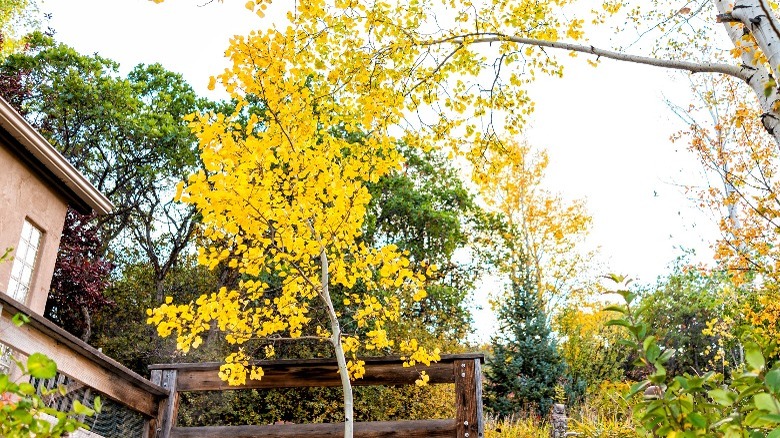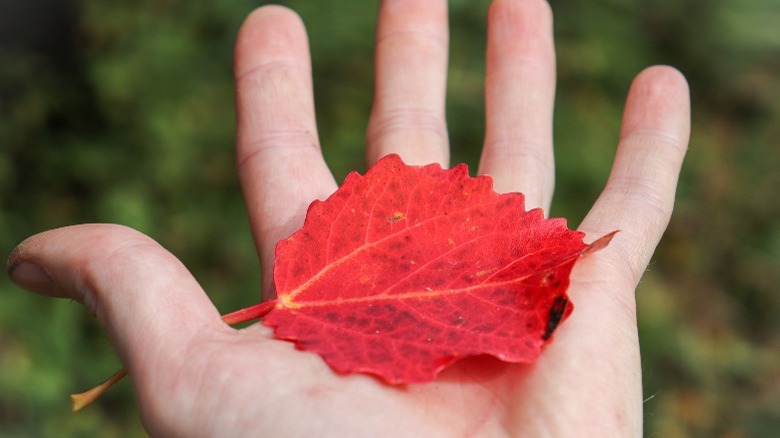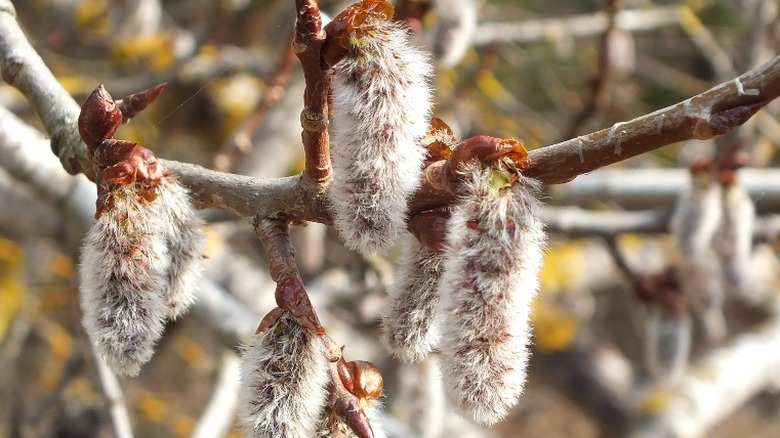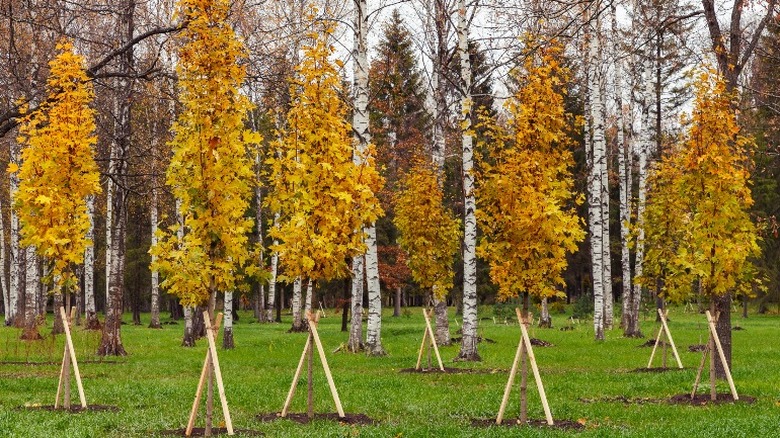How To Grow And Care For An Aspen Tree
Aspens are hardy, fast-growing trees that thrive in cold climates and mountainous or high-altitude areas. They are members of the poplar family of trees and relatives of the willow. Their red, orange, and brown autumn foliage is iconic to the species. The two most common varieties are the Eurasian Quaking Aspen, Populus Tremula, and the American Quaking Aspen, Populus Tremuloides. They are scientifically distinct species; however, they are so similar that they were called 'sister species' in a case study published by The Nature Education. The two species occupy a broader range than any other tree in the world. Pando, an ancient colony of aspen trees in Utah, is the world's biggest living organism by biomass – weighing in at 6,600 tons.
These majestic trees are beloved by wildlife, providing both shade and food to native species such as moose and deer. Their bark shines brightly in hues of light green, white, and cream, while their foliage is an explosion of colors, and the shaking of their leaves provides movement and sound in even the softest breeze. As wonderful as the aspen is, the Arbor Day Foundation warned that they aren't meant to grow everywhere. Despite their ability to thrive in some of the harshest conditions, aspens require lots of water, and their preferred climate is hardiness zones 1–7.
How to use an aspen tree in the garden
Aspens grow fast and can spread far, given the right conditions. However, individual trees won't necessarily become overbearing giants that dominate your outdoor area. Gardening Know How observed that a garden with appropriate space could establish a small aspen grove in just a few seasons.
Aspens are referred to as a pioneer species, which woodlands.co.uk defined as consistently being one of the first tree species to grow in newly cleared or burnt areas of woodland. They are well adapted for survival in the mountains and cold-weather regions of North America and Eurasia; therefore, they are intolerant of hot or dry soil. In addition, they suffer in thick, clay-based soils that are common to the lowland U.S. states. According to Ross Tree Services, the result of growing aspen in soils and areas that they are not adapted to is not only that they might not grow as quickly or display colors as vibrant as you might be hoping for, but it also makes them much more susceptible to pests and disease.
With that being said, if you can mimic the growing conditions of the aspen — loose, damp soil, low temperatures, and plenty of sunlight (at least six hours per day), growing aspen will not just add to your garden's beauty but its fertility, too, per the National Library of Medicine.
How to grow an aspen tree
Growing aspen from seed is notoriously tricky, as it is known to predominantly spread through its root suckers. Understanding how to cultivate the suckers you want, and discourage those you don't, is the key to finding success with aspens.
In early spring, on a day without frost, take some 10 to 12-inch root cuttings from a mature, well-established tree. Only take one or two from each tree to avoid damaging them too much. To help ensure successful propagation, Trees for Life suggested choosing cuttings from trees that are thriving in conditions similar to where you intend to plant yours. Plant the cuttings horizontally, in rows an inch or two apart, and cover them loosely with compost. Keep the environment moist, cool, and well-lit for several weeks until the suckers begin to emerge. When they are 2 or 3 inches tall, cut them from the root, dip the end into rooting hormone, and plant them into gritty soil to help the saplings establish roots. At this stage, The Spruce recommended using a mister to prevent overwatering or placing the whole tray into a clear plastic bag to trap and recycle moisture.
It will take roughly one to two months for the suckers to establish roots strong enough to be planted outside, and they will need constant moisture throughout that time. Once the roots are established, plant the trees into the ground in September or October or into a pot for replanting next spring.
How to care for an aspen tree
Aspen trees that are well situated are tough and require very little care. They can dominate vast swathes of a landscape without much human intervention, after all. However, most homeowners don't live within their ideal growing zones. The Spruce advised that the goal of an aspen owner is to keep soil and moisture conditions as favorable as possible, which is much easier than dealing with issues caused by planting them in an unsuitable location.
Aspens don't tolerate shade, compacted, alkaline soils, or periods of drought. At least six hours of sunlight per day is ideal. For the first few weeks of growing, keep the upper layer of soil evenly moist. Garden Guides recommended laying a soaker hose beneath a layer of mulch, which will ensure the soil is damp but not saturated. Once established, aspens only require a deep watering every two weeks or so during the summer. Feed the tree once a year in the spring with a slow-release fertilizer if your soil lacks nutrients.
Pruning dead, damaged, or diseased limbs and thinning out and removing any unwanted suckers are crucial for aspen care. Big Tool Box advocated spraying the trees with horticultural oil in late winter or early spring to kill off any overwintering fungi or parasites. This is also the best time for pruning and taking cuttings.
Is aspen toxic?
California Poison Control lists all aspen varieties as non-toxic to humans and pets. In fact, many parts of the tree are edible. The fruits of the tree are seedpods called catkins, which can be consumed raw or cooked and are rich in vitamin A. In addition, the bark can be dried out and turned into flour and is suitable for making bread or for thickening soups. The sap can also be made into syrup, according to Edible Wild Food.
However, as a member of the willow family, aspens contain compounds called salicin: also known as Aspirin. For this reason, emedicinehealth advised that anyone with stomach ulcers should avoid ingesting aspen or anything else high in these compounds, as they have been known to exacerbate symptoms in people with stomach issues. Other conditions that can potentially be made worse by salicin include diabetes, gout, blood disorders, kidney disease, and liver disease.
How to repot an aspen tree
The US Forest Service notes that aspens reproduce by spreading wide, shallow root systems that produce shoots and suckers to create more aspen trees, eventually forming a stand or grove of genetically identical trees. While they can be propagated in pots, they will eventually need to be planted outside or they will become unhappy.
Transplanting is best done in late summer or early fall when the intensity of the heat has passed, yet there's still time before winter for the plant to establish itself. Alternatively, it is also possible to plant aspen just after the final frost of spring, which will allow time for them to toughen up before the long hot days of summer.
Dig a hole around 5 feet wide and at least 1 foot deep. Remove rocks or debris and loosen the ground well to allow the roots space to expand. This is the best time to add sand, organic matter, or compost to the soil if it's not quite ideal, noted Gardening Know How. If the roots are dry, moisten them up before planting. Backfill the hole with soil and lightly compact it down enough to keep the aspen upright. Water very well at this stage and keep the soil moist for the first few weeks of establishment. SFGate strongly advises against planting anywhere within 35 to 40 feet of a structure, septic tank, walkway, or power line as the roots and suckers will easily grow up and through them.





